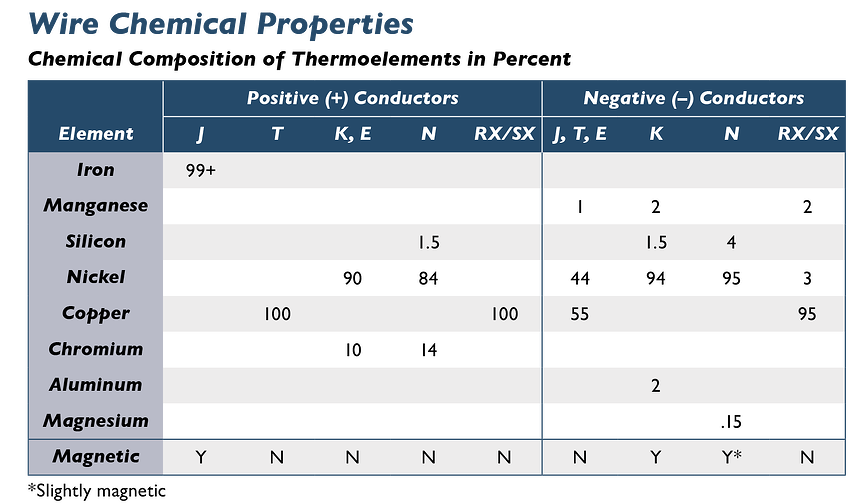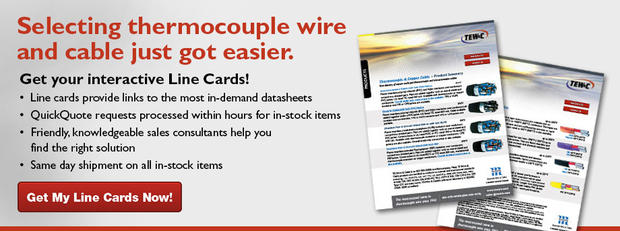Tomorrow marks my eighth year of selling thermocouple wire and cable. Like many people, I started in this industry very early and as in any niche industry most of what I learn was by seeing, listening and reading. If you are reading this, you are probably interested in a quick refresher course on thermocouple wire theory and, more importantly, the chemistry of various types of thermo elements.
Many of my friends and relatives still don’t know what I do, so I jokingly tell them that I work for a super-secret organization within Marmon/Berkshire Hathaway and I travel around the world solving people’s problems. In reality, this isn't far from the truth. I am writing these blogs to give people a little glimpse into the industrial world of temperature measurement and how temperature plays a critical role in many of today technological innovations and international standards.
While TE Wire & Cable is rather small when it comes to wire and cable in general, I believe we are innovative leaders in the thermocouple (TC) wire world. As a company, we've been in business since 1941 and our expertise is TC wire and cable both broad and extensive. I by no means know everything (who can?); therefore, many of the things I write have been researched to death by much smarter PhD level people. I welcome dialogue and corrections to some of my observations and comments.
The first topic we'll be covering is the chemical properties of various TC wires and how chemistry of the TC elements plays a vital role in TC theory as it relates to performance and results of your readings. I won't go into history, as that can be easily found everywhere.
Bottom line: A proper understanding of TC wire chemical properties translates to getting the performance you require for your application.

The Wire Chemicals Properties chart (above) shows the chemical composition of positive and negative thermo elements in type J, T, E, K, N and RX/SX thermocouple. The chemistry of the elements gives each TC type a unique property and performance parameters which then we use to classify TC wire into categories of extension, standard and special limits.
All of this sounds rather easy but in order to properly match and select the wire, lab managers require accurate understanding on how to correctly match the positive with the negative thermo elements. The most popular TC types that are in use today are type J and K. I will cover these in detail, defining their pros and cons in today's industrial applications.
Type J
Type J is the first base metal TC wire to be accepted on a large scale and to this day it continues to be popular in various industries ranging from aerospace to metal production. Many companies have converted their Type K instrumentation in recent years due to reliability and low cost that Type J affords them.
In Type J, the positive thermo element is iron and the negative thermo element is constantan, a 44NI-55Cu alloy. The commercial grade of iron used as the positive leg of Type J contains small traces of carbon, cobalt, manganese, and silicone. Due to this, the emf can vary significantly from one heat to another. The thermoelectric power of Type J as a whole is about 55 µV/⁰C ( 30 µV/⁰F) over the temperature range from 0 to 750⁰C (32 to 1380⁰F). 50 µV/⁰C per degree C at 0°C (27 µV/°F at 32°F), increases to about 54 µV per degree C at 100°C (30 µV /°F at 212°F), and 64 µV per degree C at 760°C (36 µV /°F at 1,400°F).
The thermoelectric power of Type J is higher than any of the other standard TC wire except Type E. It is always greater than that of Type K. Type J sometimes is selected because of the supposed increase of accuracy resulting from the greater thermoelectric power, however, from personal experience the greater driver for choosing Type J for recent applications has been its low cost. Due to the variance in iron emf output, one needs a matching set of constant to match the emf/temperature requirements of industry standard or customer specification. Initial calibration tolerance for Type J when the reference is at 0⁰C (32⁰F) (ASTM):

Type J thermocouple can be used in both oxidizing and reducing atmospheres up to 760⁰C. Most common uses for Type J are found in heat-treating application for aluminum and the cure of composites in autoclaves. TE Wire & Cable has Type J available from No. 8 gage up to 30 AWG (American wire gage). Smaller gage thermocouple allows for a quicker heat-sensing response. In today’s application most common gage sizes that can be found are 16, 20, and 24AWG. As TC wire diameter decreases, the recommended upper temperature limit also decreases. (Consult ASTM Metals Handbook for values.)
Coming soon: Type K
Also see: 3 Basic Steps to Selecting The Right TC Wire for Your Application
Sources:
ASTM Metals Handbook
Temperature Measurement Designed Guide, Thermo Electric Company, 1997.
F.R. Caldwell, Thermocouple Materials, National Bureau of Standards, March 1, 1962, p. 19.
 Accuclave Tracking
Accuclave Tracking
